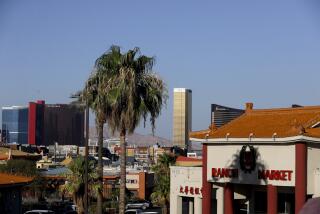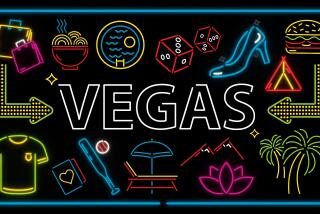The increasingly short life span of Las Vegas nightclubs
- Share via
It’s 10 p.m. on Aug. 31, and Blush, the new “boutique nightclub” inside the Wynn hotel-casino, is in the middle of its grand opening -- again. Music director and resident DJ Mighty Mi spins a standard mix of hip-hop hits past and present blended with some old disco tunes, while the crowd -- stacked with a lot of well-dressed Wynn office mice -- chats, dances and enjoys free booze.
Blush’s 4,500-square-foot interior looks good. It’s a fresh, kind of quirky mix of design elements that are at once sassy and suave. Bright paintings featuring barely discernible figures hang on the walls; 300 Asian-influenced paper lanterns hang from the ceilings; tables topped with candles and slick lamps back a rectangle of couches that outline a dance floor that glows red. And the outside patio offers, besides late-summer heat, lamps whose bases are snatched straight from a tic-tac-toe board.
Funny thing about all this is, despite its new name, new design and some new staff, Blush isn’t exactly new. When the Wynn opened in April 2005, this space wasn’t home to Blush. It was home to Lure.
Like so many night-life venues in Las Vegas, when Lure lost its luster, the suits decided to give it the club equivalent of life-saving surgery -- a face-lift.
“As people build bigger and better in Vegas, the timeline is getting cut,” says Sean Christie, Blush’s managing partner, of the shelf life of Sin City clubs.
He’s not kidding. Although the concept of shutting down a club for a remodel/redesign/reinvention is nothing new here, not to mention the night-life biz in general, an epidemic of this brand of rebranding is sweeping the city.
Besides Blush, the Luxor reopened the space formerly occupied by nightclub Ra with mega-swank mega-club LAX over Labor Day weekend. The same company in charge of LAX, Pure Management Group, which also runs celebrity hot zone Pure inside Caesars Palace, announced that another one of its venues, burlesque club Tangerine inside TI, would be undergoing a “major reinvention in early 2008,” according to a news release.
Then there’s Light, one of the first truly upscale clubs to hit the Strip and the one that many credited with taking VIP bottle service to the level all clubs emulate.
On Sept. 2, while DJ Crooked spun a mainstream mix to a packed house, the Bellagio venue danced to its grave, just six years after its opening.
With clubs boasting décor as diverse as gigantic Buddha statues and elaborate waterfalls, Light’s stripped-down design aesthetic no longer passed the gaudy litmus test of the Sin City scene.
Not that it’s going away.
Come New Year’s Eve, the club will reopen as the Bank, said Light Group, operator of several clubs.
Although managing partner Jodi Myers is keeping quiet about the new digs of the flagship club, a news release revealed that the 6,600-square-foot space would feature at least one pupil-popping element: “a glass-encased dance floor.”
“When we opened up Light, it was something new and different and innovative,” she says. “Everyone has kind of done the same thing, and it’s kind of stale. Vegas is evolving, and it’s time to do something different.”
Jesse Waits, managing partner of the other nightclub inside the Wynn, Tryst, which underwent reinvention two years ago, says the town is in a “whole new era of luxury.”
As such, it’s imperative that old venues update with “a whole new look, a whole new vibe,” which generates that most coveted and most difficult to quantify of elements -- “buzz,” he says.
Buzz is why club impresarios drop millions of dollars on renovations, says Jack Lafleur, formerly a promoter at the Hard Rock and now a freelance DJ. And given how many clubs are competing for business these days, he adds, “it’s now essential.”
Of course, there are plenty of clubs here that have never undergone extreme makeovers, including Drai’s after-hours club and Studio 54, which, at 10 years old, is considered a dinosaur. Still, even those venues have seen design tweaks.
“Vegas doesn’t really apply to the norm,” says one of the scene’s founders, Frankie Anobile, referring to other major club markets such as New York. As program director of MGM’s night-life venues, he oversaw the redesign of Studio 54, which he says can get by with relatively minor operations, such as changing its entrance.
“Even though it’s old and played out to us [locals], it’s new to 38 million people who visit us a year,” Anobile says. “They’re still blown away by it.”
Besides the increasingly crowded marketplace, Anobile says there’s a simpler reason for the diminishing life span of clubs. The city’s overall attitude toward anything not gleaming new is to blow it up and rebuild it.
“Look at what goes on in Vegas. Nothing stays old,” he says. “If it lasts for 30 years, it’s ancient. The clubs are just following that same trend as the city. The whole city’s doing it. You gotta do it too.”
Comments? Email [email protected]
More to Read
Sign up for The Wild
We’ll help you find the best places to hike, bike and run, as well as the perfect silent spots for meditation and yoga.
You may occasionally receive promotional content from the Los Angeles Times.






